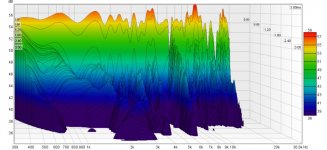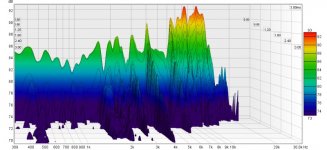Let me re-start and put everything together.
First of all, it's not a very technical design, I play around in hornresp, but I am not at any level compared to Scottmoose and GM. I can't predict how good my assumptions are and if a simulated response shows up in real life.
I was inspired by an existing design by an old master (the Olson backloaded corner horn) and the Jensen corner Imperial, the JBL scoop/Harkness, the Tannoy horns etc, but have less space and believe each driver deserves its own alignment. I have enjoyed building Bigger Is Better pipe horns and I find the basic algorithm for laying out a BIB very effectice and reliable. When I saw that the length of the Olson horn was close to the length of one of the three BIB designs I built (and really, REALLY liked), I decided to investigate re-rolling and tweaking the Olson.
So, again, my design for the Fane FC-152F01TCis an off-set driver pipe horn intended for corner placement, with parabolic expansion (a BIB but with less volume) and folded into a rectangular box. The mouth fires down and exhausts to the sides and back. Response is smooth and rolls off gently towards the lower range. With room gain, extension should go below 30 Hz. (Depends on the room it is placed in, I deduced my room gain from measurements on a sealed box subwoofer of known parameters.) Size is 43.6 cm wide, 120 cm high, 60 cm deep.
As you can see inside, pretty much a simple BIB fold. I will add some bracing.
Here: red line is the original Olson corner horn which inspired the design, gray is my take on it.
Minimal damping in red, more material in the tip in gray (more or less tuned to my room gain).
And with room gain:
First of all, it's not a very technical design, I play around in hornresp, but I am not at any level compared to Scottmoose and GM. I can't predict how good my assumptions are and if a simulated response shows up in real life.
I was inspired by an existing design by an old master (the Olson backloaded corner horn) and the Jensen corner Imperial, the JBL scoop/Harkness, the Tannoy horns etc, but have less space and believe each driver deserves its own alignment. I have enjoyed building Bigger Is Better pipe horns and I find the basic algorithm for laying out a BIB very effectice and reliable. When I saw that the length of the Olson horn was close to the length of one of the three BIB designs I built (and really, REALLY liked), I decided to investigate re-rolling and tweaking the Olson.
So, again, my design for the Fane FC-152F01TCis an off-set driver pipe horn intended for corner placement, with parabolic expansion (a BIB but with less volume) and folded into a rectangular box. The mouth fires down and exhausts to the sides and back. Response is smooth and rolls off gently towards the lower range. With room gain, extension should go below 30 Hz. (Depends on the room it is placed in, I deduced my room gain from measurements on a sealed box subwoofer of known parameters.) Size is 43.6 cm wide, 120 cm high, 60 cm deep.
An externally hosted image should be here but it was not working when we last tested it.
As you can see inside, pretty much a simple BIB fold. I will add some bracing.
An externally hosted image should be here but it was not working when we last tested it.
Here: red line is the original Olson corner horn which inspired the design, gray is my take on it.
An externally hosted image should be here but it was not working when we last tested it.
Minimal damping in red, more material in the tip in gray (more or less tuned to my room gain).
An externally hosted image should be here but it was not working when we last tested it.
And with room gain:
An externally hosted image should be here but it was not working when we last tested it.
Very good. 
Just one note: It's better to upload the photos to diyaudio than hosting them on a different site, because quite frequently the adress to the picture changes from the host side, and even now I can not see the pictures in your post because there is a redirect happening. So in order to see your pictures, I have to open them in another tab.
Just one note: It's better to upload the photos to diyaudio than hosting them on a different site, because quite frequently the adress to the picture changes from the host side, and even now I can not see the pictures in your post because there is a redirect happening. So in order to see your pictures, I have to open them in another tab.
One thing that has surprised me is that I find these speakers very easy to listen to. Obviously you can turn the volume way too high and then it definitely gets harsh on your ears. But on reasonable and low volume levels there is almost zero fatigue in my experience. On paper that makes very little sense, but in real life these drivers are very pleasing to listen to.
Are you saying there's a correlation?So the rising response is not harsh? Are you listening in open baffle?
Member
Joined 2009
Paid Member
One thing that has surprised me is that I find these speakers very easy to listen to. Obviously you can turn the volume way too high and then it definitely gets harsh on your ears. But on reasonable and low volume levels there is almost zero fatigue in my experience. On paper that makes very little sense, but in real life these drivers are very pleasing to listen to.
I found something similar with fostex drivers in the past. It's fine at low volume because the cone resonances are not excited too much. What is there, gives the sound 'air' and human voices take on a certain presence. Both result in increased listening pleasure. But sooner or later you'll be turning it louder on your favourite tracks, and some of them will excite those resonances and you become familiar with them, you recognize their presence. Then you find even at low volume you can hear the annoyances. Slowly you start avoiding certain music and certain recordings.
Eventually you look for a different driver.
One cone treatment that I have found useful is to smear some silicone on the backside of the driver, just around the edge of the cone near the surround, about 1cm wide strip all the way around. It tends to damp some of the cone resonances that have modes at the edges. And also on the back of the whizzer cones, near their edges, just a light smear on the back. The silicone doesn't harden (you want the stuff that doesn't harden, used as a flexible sealant) and acts to dissipate energy of resonances.
Last edited:
Are you saying there's a correlation?
No not at all. Believe me I am no expert at any of this. I am interested in using these in OB
Dear Fane lovers and owners,
Not sure if this question was asked before in this thread. How does Fane 152F01TC compared to SOVEREIGN 12-250TC ? Is there a reason why one should go for 15'' instead of 12'' which I refer to 12-250TC for a OB setup?
I look at their specs they both look very similar. TSPs of 15 is a bit different than 12 in BL 11 vs 13; Sd 855 cm2 vs 530.9 cm2 and Efficiency 2.9% vs 1.3%. Should I say 15 spec seems better than 12 for OB setup ?
I'm also interested in building 15'' Fane as OB setup. I got OB bug ever since I was successful with my 1st OB DIY
Last question, where is the best site with good deal to order a pair of Fane 15 or 12 and shipped to the US ?
Thanks,
Tom
Not sure if this question was asked before in this thread. How does Fane 152F01TC compared to SOVEREIGN 12-250TC ? Is there a reason why one should go for 15'' instead of 12'' which I refer to 12-250TC for a OB setup?
I look at their specs they both look very similar. TSPs of 15 is a bit different than 12 in BL 11 vs 13; Sd 855 cm2 vs 530.9 cm2 and Efficiency 2.9% vs 1.3%. Should I say 15 spec seems better than 12 for OB setup ?
I'm also interested in building 15'' Fane as OB setup. I got OB bug ever since I was successful with my 1st OB DIY
Last question, where is the best site with good deal to order a pair of Fane 15 or 12 and shipped to the US ?
Thanks,
Tom
Dear Fane lovers and owners,
Last question, where is the best site with good deal to order a pair of Fane 15 or 12 and shipped to the US ?
Thanks,
Tom
I don't know about USA but Blue Aran in the UK sells many Fane speakers.
Blue Aran - Professional Sound and Lighting They might export them for you?
Last question, where is the best site with good deal to order a pair of Fane 15 or 12 and shipped to the US ?
Thanks,
Tom
Fane FC-152F01TC – Thomann United States
I don’t know if it is the best site but they are available at the link above.
Tom
I have a pair of each and have been happily listening to the 15's for a few weeks. I plan to switch and play the 12's before I cut the baffle, 24x40 inches, on the finish speakers. The dealer for Canada and USA is Solen.ca which luckily for me is a 25 minute drive from home. The issue is getting stock as these drivers are very popular.
I have a pair of each and have been happily listening to the 15's for a few weeks. I plan to switch and play the 12's before I cut the baffle, 24x40 inches, on the finish speakers. The dealer for Canada and USA is Solen.ca which luckily for me is a 25 minute drive from home. The issue is getting stock as these drivers are very popular.
Thank you for the feedback nigle, slam630 and Jazzfan
Jazzfan, thanks for the us/can link. When you get a chance to try out 12, would you let me and everyone in here know your impression b/w the 2 ?
Thanks
Tom
They are a lot cheaper and in stock at my link
They are a lot cheaper and in stock at my link
Sorry, they were out of stock at Blue Aran.
I should have checked first.
- Home
- Loudspeakers
- Full Range
- New 15" full range - FANE

